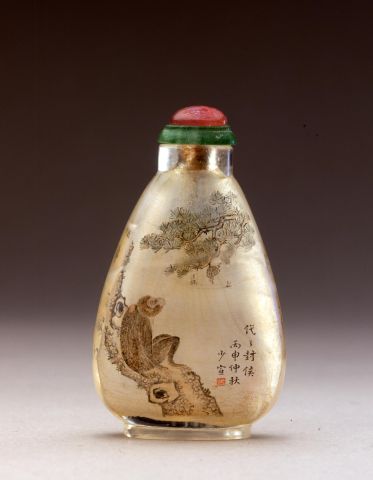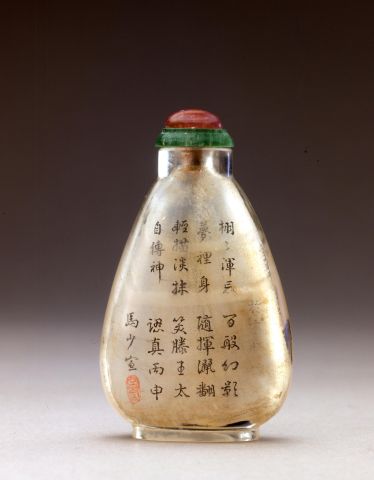

壶编号: 00036
內畫,馬少宣,猴踞枝頭
年代: 1896
高度: 55 mm
水晶料,水墨設色,內部掏空非常規整。器身扁平修長,橢圓形狀,至瓶頸處漸漸收緊,內畫精緻。一面內畫繪有松枝下端坐一猴,仰視松下昆蟲飛舞,旁有銘文:“代代封侯”。又有“馬少宣”題字,時為1896年秋仲月;另一面內畫繪有行楷對偶詩句:上句為“百般幻影隨揮灑”,下句為“翻笑滕王太認真”。 也有“馬少宣”簽印。
类似物品:
Little, Stephen L. and Joseph B. Silver. The World in a Bottle: Chinese Inside-Painted Snuff Bottles from the Collection of Joseph Baruch Silver And Traditional Chinese Paintings, 1994, p. 11, no. A6.
来源:
Clare Lawrence Ltd.
Sotheby's, London, March 3, 1987, lot 156
Eric Young
Sotheby's, New York, November 3, 1982, lot 260
Captain S. N. Ferris Luboshez, USN [Ret'd]
展覽:
Annual Convention ICSBS Toronto, October 2007
There are very few bottles of this shape used by Ma in his painting, but the similar example cited above in the collection of Joseph Silver is interesting, not only for its shape, but for the similar positioning of the two inscriptions on one side. In addition to this, both bottles were painted in the same year - 1896; the one above is dated 'Autumn' and the Silver bottle, 'Winter'. Ye Zhongsan also used this shape of crystal bottle from 1898 and since this is not a common "older" form for a crystal bottle, it is likely that these were being made specifically for the inside painted artists of Beijing.
A comparison of the two inscriptions on the Ma bottles is also intriguing, since although the subject matter is completely different, the lower inscription of the bottle illustrated above is almost identical to the upper inscription of the Silver bottle. The reference to Prince Teng on only one bottle would suggest that this bottle may have been a commission for one of the Manchu princes related to the Guangxu Emperor. Prince Teng (Li Yuanying) was one of the younger brothers of Emperor Taizong (Li Shi, AD 599-649) of the Tang Dynasty. However, to find two bottles with virtually the same inscription makes that idea somewhat implausible. In spite of this, the main side of the bottle would lend credence to this notion as the visual pun is straight-forward and supported by the accompanying inscription. The combination of a monkey (hou) with a pine tree and bees (feng) forms a rebus almost identical to the inscription "May you (and your descendents) be ranked as marquises generation after generation".
The upper inscription of the bottle alludes to the well-known Daoist story of the Zhuangzi where Zhuangzi dreams he is a butterfly. The book Zhuangzi, of the same name as the accepted author, is a composite of philosophic writing of which the first seven chapters are traditionally thought of as being written by Zhuangzi himself. In Chapter 2, entitled "On Arranging Things", Zhuangzi dreams that he is a carefree butterfly. After he awoke, he wondered how he could conclude whether he was Zhuangzi who had just finished dreaming he was a butterfly, or whether he was a butterfly who had just started dreaming he was Zhuangzi. This is referred to as the Transformation of Things - how do I know why it is so, or how do I know why it isn't so?
To the right hand side of the 'inscription side' of the bottle is a very worn four character inscription which cannot be translated, although the first character beginning above the lower couplet might be "at" (as in "made at/in").

 英语
英语 中文
中文